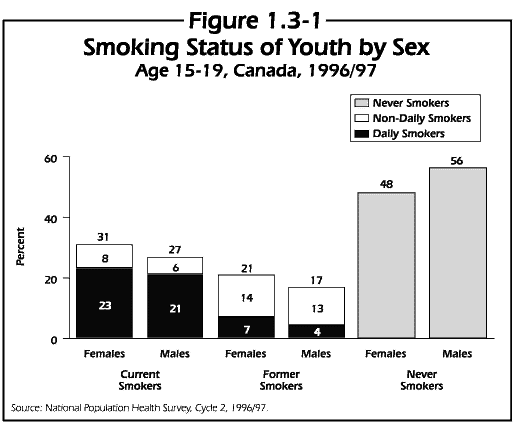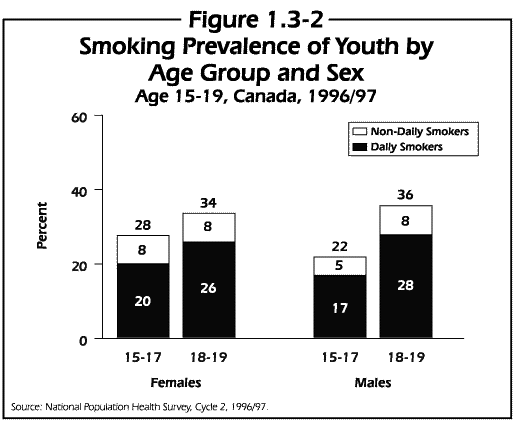Centre for Chronic Disease Prevention and Control
Cancer

Smoking Behaviour of Canadians
Cycle 2, 1996/97 (January 1999, No. 1)
Profile of Youth Aged 15-19
Youth Smoking Prevalence
In 1996/97, an estimated 621,000 youth aged 15 to 19 were current smokers (29%).
In this age group, 27% of young males and 31% of young females smoked. These smoking prevalences were similar to
those reported two years earlier by the 1994/95 National Population Health Survey (NPHS), Cycle 1. The overall
smoking prevalence among youth in 1994/95 was 29%, with prevalences of 28% and 30% among males and females respectively.
This relatively short comparison time frame (from 1994/95 to 1996/97) does not address changes in youth smoking
rates of the early 1990s.
In 1996/97, 52% of 15-19 year olds reported that they had never smoked and
19% reported smoking in the past (5% former daily and 14% former occasionally), but not at the time of the survey.
Youth who did smoke were much more likely to smoke on a daily basis than occasionally (Figure 1.3-1).

Smoking prevalence increased dramatically with age within this 15-19 age group.
An estimated 25% of youth aged 15-17 were current smokers in 1996/97, compared with 35% of youth aged 18-19. Significant
increases in smoking prevalence across these age groups were seen among both males and females (Figure 1.3-2).

Among the four regions of Canada (Atlantic, Quebec, Ontario, and Western provinces),
the smoking prevalence among 15 to 19 year olds was highest in Quebec, at 36%, which exceeded the national rate
by 7 percentage points. In the other regions, Ontario had the lowest percentage of current smokers in this age
group (25%), and the Atlantic and Western regions, at 28% and 29% respectively, were similar to the national average.
Small sample sizes for this age group in some provinces precluded any further detail.
Amount Smoked
Male youth who were daily smokers in 1996/97 smoked an average of 13 cigarettes
per day. This was significantly lower than the amount reported by 15 to 19 year-old daily smoking males in 1994/95
(16 cigarettes/day). Female daily smokers of the same age group smoked an average of 11 cigarettes per day in 1996/97,
the same average as females aged 15 to 19 in 1994/95.
Starting and Quitting
The design of the NPHS allows for the tracking of individual smoking behaviour
over time. The following discussion refers to those youth who were between the ages of 15 and 19 in the 1996/97
survey, and describes how their behaviour changed since they were first surveyed in 1994/95. Because of the
small number of youth surveyed in both Cycle 1 and Cycle 2, only a general overview of starting and quitting behaviour
was possible and results should be interpreted with caution.
An estimated 175,000 youth started smoking cigarettes for the first time between
1994/95 and 1996/97, representing 14% of never smokers in 1994/95. Interestingly, another 206,000 youth who were
never smokers in 1994/95 reported being former smokers in 1996/97, suggesting substantial first time experimentation
with cigarettes during this time period.
Almost 192,000 youth who were former smokers in 1994/95 had resumed smoking by
1996/97 (42% of young former smokers). This means that almost half of the youth who quit smoking in the past had
relapsed by the 1996/97 survey.
Among those who were smoking daily in 1994/95, 80% were still smoking every day
when surveyed in 1996/97. Overall, 53% of male and 53% of female daily smokers stated that they were considering
quitting within the next six months.
Of the more than 408,000 young smokers in 1994/95, more than 67,000 (16%) had
quit by 1996/97. However, as described above, these young smokers who quit were replaced by 367,000 youth who started
(175,000) or resumed smoking (192,000) by 1996/97.
Estimation of Addiction
The amount of time that elapses from when daily smokers wake up to when they
have their first cigarette is one measure of how addicted they are to smoking. An estimated 44% of young daily
smokers (aged 15-19) reported smoking their first cigarette within 30 minutes of waking (19% within the first 5
minutes and 25% within 6-30 minutes of waking). This compares with 49% of 20-24 year olds and 62% of daily smokers
aged 25 and over who smoked their first cigarette within 30 minutes of waking.
Among youth who smoked every day, the time elapsed until first cigarette in the
morning showed no relationship to reported intent to quit within the next six months.
|
Terminology
- Current smoker - was smoking at the time of the interview, and includes
daily smokers and non-daily smokers (also known as occasional smokers). Smoking status was determined
from the response to the question: "At the present time do you smoke cigarettes daily, occasionally or not at all?"
- Former smoker - was not smoking at the time of the interview, however
answered "YES" to the question: "Have you ever smoked cigarettes at all?" Former daily smokers and former
occasional smokers were then determined by their response to the question: "Have you ever smoked cigarettes
daily?". In Cycle 2, time since quitting was not collected.
- Never smoker - was not smoking at the time of the interview and answered
"NO" to the question: "Have you ever smoked cigarettes at all?"
- Non-smokers - are former smokers and never smokers, combined.
- Prevalence of smoking - the proportion of cigarette smokers in the specified
population.
- Amount smoked - the number of cigarettes smoked per day for daily smokers
only.
- Quitters - those individuals who classified themselves as either "daily"
or "occasional" smokers in 1994/95, and then as "former smokers" in 1996/97.
- Environmental tobacco smoke (ETS) - also known as second-hand smoke.
Exposure to ETS was determined from the response to the question: "Does anyone in this household smoke regularly
inside the house?"
|
|
![]()





